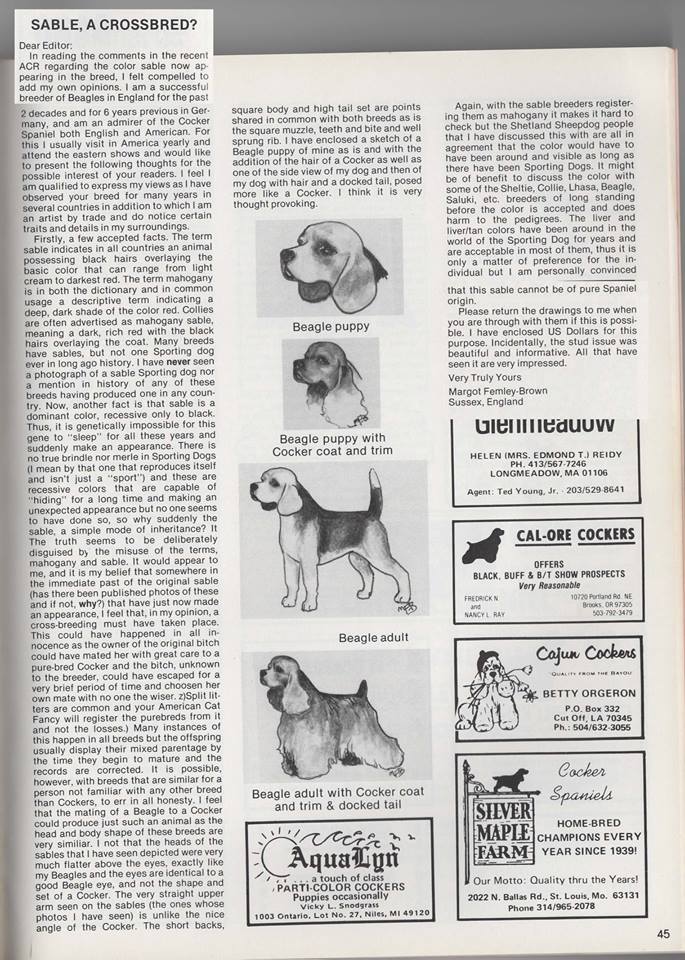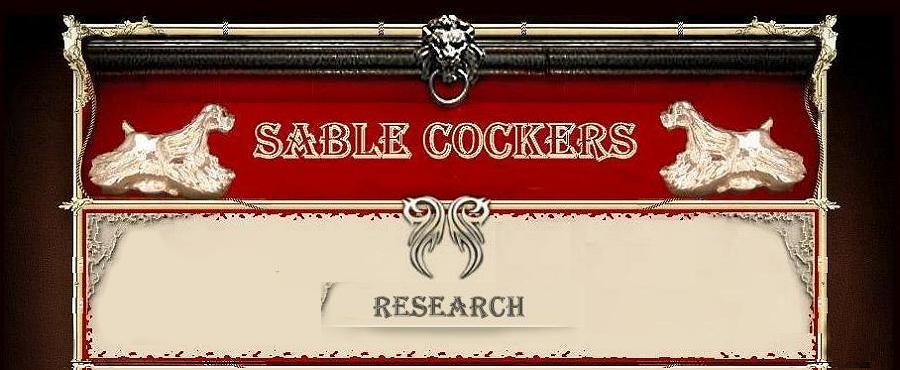Now comes to a few articles
that were written by the late Michael Allen, who had the American Cocker
Magazine. She was against sable..or actually it seemed, against a couple
of breeders.. This is what started much of the huge war about sable cockers
that eventually got them thrown out of the American AKC show ring.
You can read and
see for yourself, that this indeed, was a sad situation, not only showing
the lack of knowledge of genetics but also that no actual research was
done to come to any truthful conclusions.
On the next page, we have
listed actual early sable cockers with links to their pedigrees that were
registered in the AKC as well as CKC stud books, many well before the split
from the English cocker.
We also have an article
about the little black bitch that produced sable that Ms Allen referred
to in her articles.

Article: Do We Have A
Standard?
DO WE HAVE A
STANDARD?
This is a review of information that was written in an editorial by Michael
Allen named "We Do Have A Standard" in her magazine
The American Cocker Magazine.
The entire article follows this review.
When Ms. Allen wrote this
she stated 'I have searched through the Cocker books of the past such as
Ella Moffit's, Ruth Kreauchi's original effort in 1956 and others and this
problem was not mentioned, in print at least, at any time in the published
history of the Cocker Spaniel.'
I would say by that very comment, she did not go looking very hard when
the American Kennel Club, decades before, registered American Cocker Spaniels
as sables. *See the documentation on web site
One thing she fails to mention is the fact that Dr. Phillips, in Ella Moffit's
book that she quotes in her article, talks about the red cocker as being
a deep mahogany shade and it being the most desirable color in reds.
With so many sables that were registered during the previous decades as
mahogany, "IS THIS REALLY THE COLOR HE WAS TALKING ABOUT???"
Sable!!!!
By her own words, Ms. Allen, has shown that she does not understand coat
color inheritance of the sable gene.
Now for her article:
WE DO HAVE A
STANDARD EDITORIAL
The time has come
it would seem for comments from your editor on a current problem.
the above mentioned problem should not exist, in fact I have searched through
the Cocker books of the past such as Ella Moffit's, Ruth Kreauchi's original
effort in 1956 and others and this problem was not mentioned, in print
at least, at any time in the published history of the Cocker Spaniel.
This situation is very basic and simple. There has arisen of late
within the past few years, a color new to the breed and to Sporting dogs
but very old to all other groups of dogs, i.e. sable. This is any
buff based color from light silver to dark red with an overlay of black
hair. this is a perfectly legal and desirable color in many breeds
including Dachshunds Sheepdogs, German Shepherds, Lhasa Apsos, etc. a glance
at the American Kennel Club Dog Book will show you the standards of all
breeds and show you the standards of all breeds and their accepted colors.
It will also show you that this is NOT an accepted color for the Cocker
Spaniel nor of any other sporting breed.
The official American Kennel Club approved standard of our breed is like
a law. It is our only guideline for breeding our dogs and for their
exhibition. To introduce a "rare" color is breaking the law.
The last standard change presented this "new color" for the fancy to consider
inclusion and it was rejected. Thus, the color sable is not an allowed
color and should not be bred. The law is simple. We have a
wide range of attractive colors that are permitted, so what is the
actual purpose of introducing a "new one"?
This is an important question
that breeders should ask themselves honestly.
Secondarily, in searching the books it is a fact that I found absolutely
no mention of sable or of any color that remotely sounds like it.
Phillips in his chapter on color in the Moffit book of 1935, made several
derogatory comments about livers in stating his opinion and he mentioned
blues, fawns and whites as examples of the unusual colors in the breed
but no sable. As former editor of the Review and current editor of
the Magazine, I have made every attempt to persuade the very few sable
breeders to present their side of the situation by sending me articles
on where their first sable came from and copies of their photographs, in
the interest of fairness and impartial editorialism, I have repeatedly
made this request over the telephone and by letter but I have not received
the above material. In this situation, I feel that casual opinions
as to the vague possibility as to what dog in the far distant past MIGHT
have carried the gene is of no value. Proof is needed. In many
long discussions with other breeders of long standing of several breeds
that do allow the color, they have all agreed that a gene that is recessive
only to black but dominant to others connot "sleep" for decades and then
make a surprise appearance. In some pet shop, some article, in some
back yard, some person would have had it and made mention of it's existence,
such as in the case of the blues. Even the undesirable muddy fawns,
very rare are mentioned in old books but no sable. The breed simply
does not carry the gene for merle, brindle, the masking gene such
as found in Great Danes and several other common traits in other breeds
but not Cockers. The Phillips article also mentions that he had never
seen the black and tan with the heavy extension of tan so that the animal
has a saddle like Beagle. Now I have very recently, but the Cocker was
admittedly no pure Cocker.
This is a serious situation and should be given some appropriate thought.
Readers, ask yourselves these questions? Where did the color suddenly
come from? Why was it not in evidence until recently? If you
feel that it was evidence, where is the proof? There are other people
who have read and respected our standard. A well known and very highly
thought of judge just excused the sable and white from the ring the first
day of the Houston Astrodome weekend. She is to be commended for
her courage as she is hired to judge the dogs by the written stand and
it clearly states and describes the allowed colors. In ASCOBs, it
states "solid color" A sable us certainly not solid. In parti-Colors,
it states, "definite colors appearing in clearly defined markings"
It mentions roans also as acceptable. Not sable. Let us all
put aside personal feelings and think about these "new" color.
Editor *footnote:
Proof of this color's dominance is clear. The people who have bred
their bitches to sable dogs have gotten sables in the first litters.
As these bitches heritage is known to all and the individual's have been
seen by either a few or a great many persons and know to be not-sable,
the appearance of the sable puppies in the litters is proof of the dominance
of the gene, If it were recessive, both parents would have to possess
it and the ancestry of the bitches who have produced the sable puppies
(to the best of my knowledge) are clear of this color as they are known,
and photographs exist of them. The individuals behind the sable sires are
not so known.

This is the "letter to the editor"
that appeared
in the March/April 1981 issue of The
American Cocker Review
magazine that started the sables come
from beagles rumor. I
t is from a " Margot Femley-Brown
of Sussex, England" complete with
drawings "she" did. Funny
how she draws exactly like Michael Allen! .....
The letter starts at the
bottom of page 44, covers all of page 45 with
some ads, and concludes
on page 46.
Thanks Evelyn Bravo for
providing this

|

